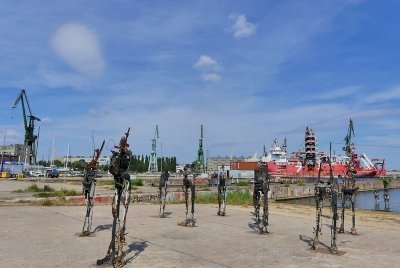
I visited Gdansk in August 2020 after a detour to Gdynia which turned out to be a wise choice as the only huge traffic jams I encountered in Poland during the COVID-19 crisis were the several lanes from Torun or Warsaw towards Gdansk and the Baltic Sea. Having driven quite early to Gdynia avoiding the main roads, I luckily skipped all the traffic and on the way back to Gdansk, the traffic flow was fine. If you travel by car, there's ample paid parking spaces next to the Gdansk shipyard area or next to the European Solidarity Centre and you can pay using a credit card if you're short of zloty coins.
With a bit of prior preparation, I opted to visit solo and follow the 13 'sites' along the Imperial Shipyard Route to learn about the rich history of the once inaccessible imperial shipyard and the unique history of the Gdansk shipyard and the strike in August 1980 which made this area famous all over Europe (so much so that the place is marked as "Europe starts here") if not worldwide. Most of the shipyard is still pretty much operative and at times it feels a bit awkward to roam around freely in somebody's active workplace, but on the whole the workers seem to have got used to it. There are permanent exhibitions on Solidarnosc as well as temporary exhibitions which are changed every now and then. I particularly liked the robot invasion exhibition made up of mechanical and shipping spare parts on a slipway (photo).
Stocznia Cesarska's (SC) mission or masterplan to remember, reconnect and reimagine this important site of memory and freedom is worth mentioning. By reinforcing social and historical qualities of key existing buildings and structures of the shipyard of irreplaceable value to the city of Gdansk and its people. These buildings have shaped the very foundation of the city and have withstood both success and hardship of Gdansk. In order to remember and reinforce these qualities, SC's vision is to preserve, activate and use as many of the existing buildings and structures as possible in a new urban environment.
The current area of the imperial shipyard was originally planned as separated from the city. In imperial times, the harbour was seen as purely industrial and lacking urban qualities. Throughout the past two centuries, walls and fences have been put up to isolate the shipyard from the heart of Gdansk. Nowadays instead, the idea is to reconnect and integrate the shipyard to the city centre.
Last but not least, the historical heritage and the various qualities of the existing buildings and structures make the imperial shipyard an entirely unique development project. The existing buildings hold a great untapped potential for hosting and fostering new urban life and the idea is to reactivate the old heritage functions as a catalyst for urban life including cultural, commercial, and arts programmes. This can be seen as a double-edged sword when compared to what happened in 'similar' sites such as Liverpool's Maritime Heritage. If managed well this could be a strong point but if this become an excuse to 'develop' modern eyesores which replace or take over the heritage landscape, in my opinion the result can be counterproductive in the long run. In fact, the rusty and chunky look of the European Solidarity Centre is already more than enough but at least, in a way, the interior certainly makes up for the exterior.
When compared to recent industrial WHS inscribed on the WH list, such as Japan's Meiji Industrial Revolution, I think that this tentative WHS has a good chance to make it on the list despite Poland's less-than-ideal past attempts to add a WHS in Gdansk. If it will ever make it on the WH list, I think it will be thanks to the intangible value of this site, as was the case with other WHS in Poland such as Auschwitz/Birkenau WHS and the A-Dome of Hiroshima, Japan. That said, the 'old town' of Gdansk is definitely a worthwhile destination to visit and is on par with the reconstruction efforts and historic ensembles portrayed in the Warsaw and Torun WHS (if not better than the latter!).
Comments
No comments yet.
